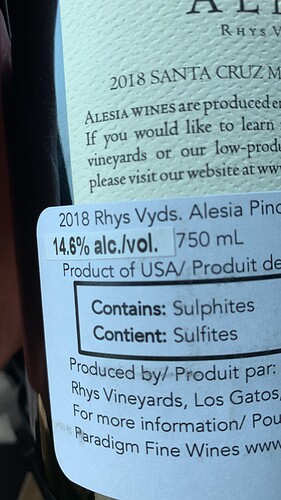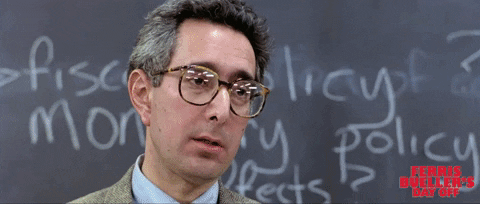Greetings all. Been drinking Rhys for many years now, and have quite enjoyed the majority of what I’ve had the opportunity to taste. I’ve always appreciated the fact that they kept the alcohol levels very restrained, when many others push to 14% and beyond.
I ordered this particular bottling based on a John Gilman note pegging it at 13.2%, however, when it arrived for pickup, I noticed that the monopoly here had corrected the alcohol to 14.6%, presumably based on their own analytical testing.
I peeled back the sticker to see that Rhys had labelled the ABV at 13.1%, so there seems to be a 10% variance between their testing and that of the LCBO.
In tasting what is in the bottle, I definitely notice more warmth than I was expecting, but am wondering if my mind it playing tricks. Ultimately, I wasn’t particularly enthralled with the wine, but that’s not saying much as I’m going through a bit of a Fu phase, myself.
I know discrepancies like this can be common when the bottle says something generic like 14%, but unusual in circumstances like this where the producer has purposely specified to the nearest tenth of a percentage.
I am curious as to how this discrepancy might occur and whether anyone else has seen such re-labelling in their respective markets. One potential answer is that the LCBO is incompetent, which, given my own personal experiences with this bloated, inefficient monopoly, is highly likely. However, the warmth and ripeness I perceive in the wine itself makes me wonder if in spite of their incompetence, the LCBO testing is correct in this case.
Any insights are appreciated.
Assuming the 14.6% figure is correct, the lowest abv. that should be allowed on the label is 14.0%, and the highest allowable abv. figure on the label would be 15.6%.
You get a tolerance of 1.5% abv below 14.0%, and you get a tolerance of 1.0% abv. above 14.0%, but you can’t use these tolerances to cross-over the 14.0% dividing line.
This is based on my reading and understanding of the information here: https://www.ttb.gov/labeling-wine/wine-labeling-alcohol-content#:~:text=Example%3A%20A%20still%20grape%20table,BY%20VOL.%E2%80%9D%20is%20permissible.
1 Like
Andrew and I went back and forth on this one as I also ordered it and opened it on the same night. This is a wine I definitely found deeper pitched, richer, and a bit more alcoholic on the finish than I’d usually associate with Rhys from the Santa Cruz Mountains. I think I tolerated it a little more than you, Andrew, but I have to say I was also just a little disappointed as it lacked the elegance I’d usually want from the producer. Not complaining too much as the price was modest and I realize this is declassified juice.
-
2018 Rhys Alesia Pinot Noir Santa Cruz Mountains - USA, California, Santa Cruz Mountains (5/19/2023)
This pours medium to light purple in the glass. The nose is of dark cherry, blueberry, sassafras, tree bark, cinnamon, a whiff of grapefruit peel, alpine forest, violets, and dry dusty soil. The palate enters on the deep rich fruit via dark cherry and blueberry turning to medium plus tannin and medium plus acid. There is a pleasant twang of grapefruit zest on the finish, but unfortunately a little of the alcohol pokes through too and just a touch of prune as well. All in all I found this to be an enjoyable experience but not quite at the level of my favorite bottles from the producer. The fruit is deeper pitched than I'd prefer. More Alpine than Family Farm in nature in that way but even more so than Alpine can be. I also found it interesting that our local liquor monopoly lab tested this at 14.6% alcohol, despite the actual original label indicating 13.2%. (91 points)
If I didn’t have any information on the alcohol, and tasted this blind I think I’d guess high 13s or low 14s.
Curious if anyone from Rhys has any comments on this one. @Kevin_Harvey @Jeff_Brinkman
1 Like
Andrew,
Are you located in Canada? The Canadians actually TEST each wine that gets imported into that country and require wineries to change their labels in the case that they are not ‘in compliance’ with Canadian rules and regulations.
What Brian discussed is correct - for sale in the US. As I said, if you really want to know what ABVS are, check out wines sold in Canada and how often those little stickers need to get placed over ‘stated’ alcohol levels . . .
Cheers

